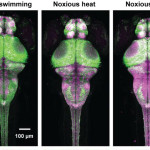Basic biology research at Lawrence Berkeley National Laboratory (Berkeley Lab) has led to the formation of Cinder Biological, or CinderBio, a startup company producing a new class of enzymes made from microbes, or extremophiles, that thrive in hot volcanic waters. Co-founded by Molecular Biophysics & Integrated Bioimaging scientists Steve Yannone and Jill Fuss, CinderBio will … Read more »
New Clues on How Cell Nucleus Gatekeeper Works
Scientists have gained insight on how some molecules are allowed to enter and exit the nucleus while keeping other molecules out. Their research, led by Mohammad Mofrad in the Molecular Biophysics & Integrated Bioimaging Division, is a step forward in building a more comprehensive understanding of nuclear pore complex function, which has numerous implications in … Read more »
A Designed Protein Maps Brain Activity
A team of scientists from the Howard Hughes Medical Institute’s Janelia Research Campus designed a fluorescent protein (CaMPARI) that causes permanent marking of active brain cells. They validated this new tool via x-ray crystallographic studies at the Berkeley Center for Structural Biology at the Advanced Light Source.
It Takes a Thief: Discovering How Bacteria Capture Genetic Info
Jennifer Doudna and James Nunez led a study at the Advanced Light Source that revealed the structural basis by which bacteria are able to capture genetic information from viruses and other foreign invaders for their own immunological system. This discovery holds promise for studying or correcting problems in human genomes.
Berkeley Lab scientists to help build world’s first total-body PET scanner
Scientists from the Department of Energy’s Lawrence Berkeley National Laboratory (Berkeley Lab) have set out to help build the world’s first total-body positron emission tomography (PET) scanner, a medical imaging device that could change the way cancers and other diseases are diagnosed and treated. The project is a consortium led by a UC Davis research team … Read more »
Was this page useful?








